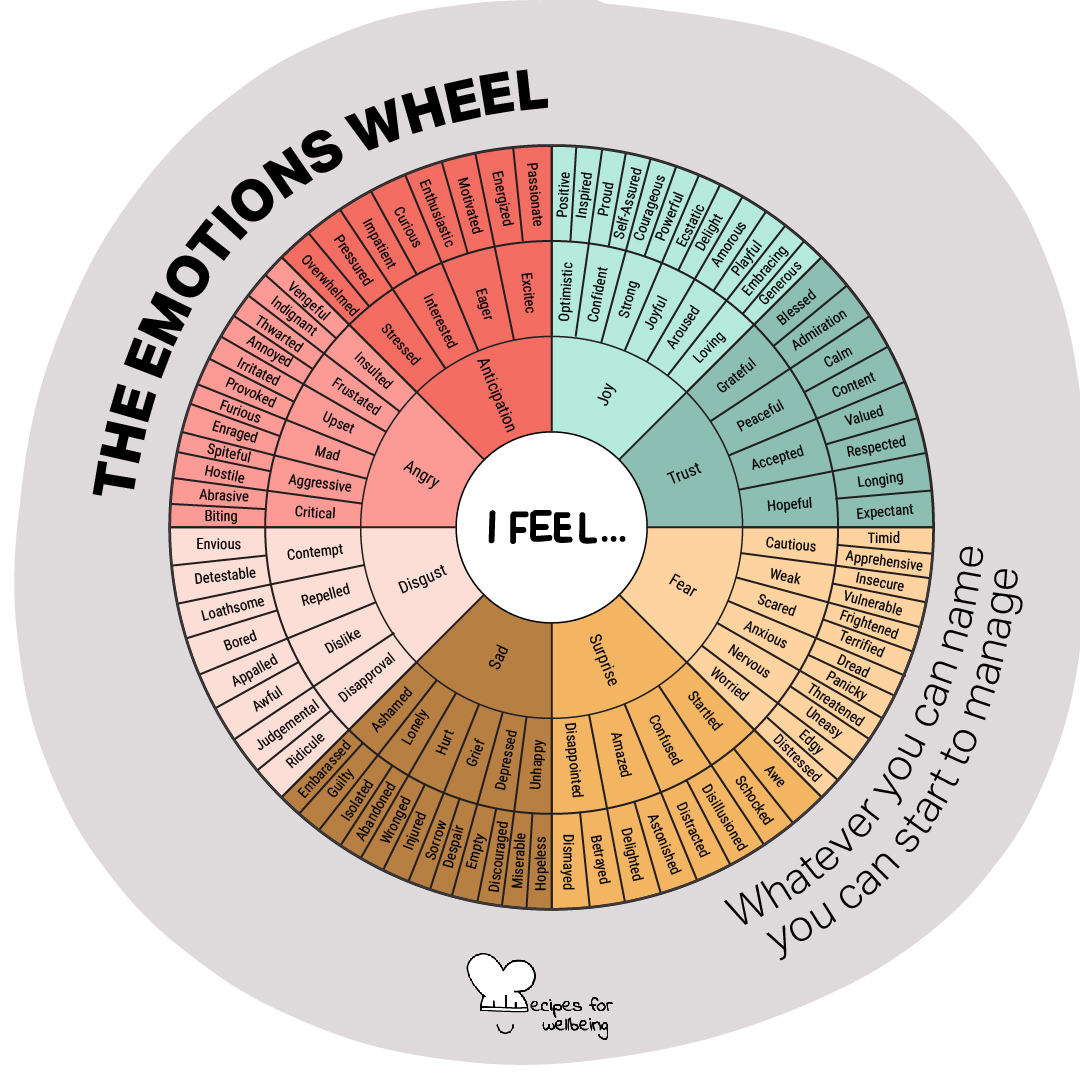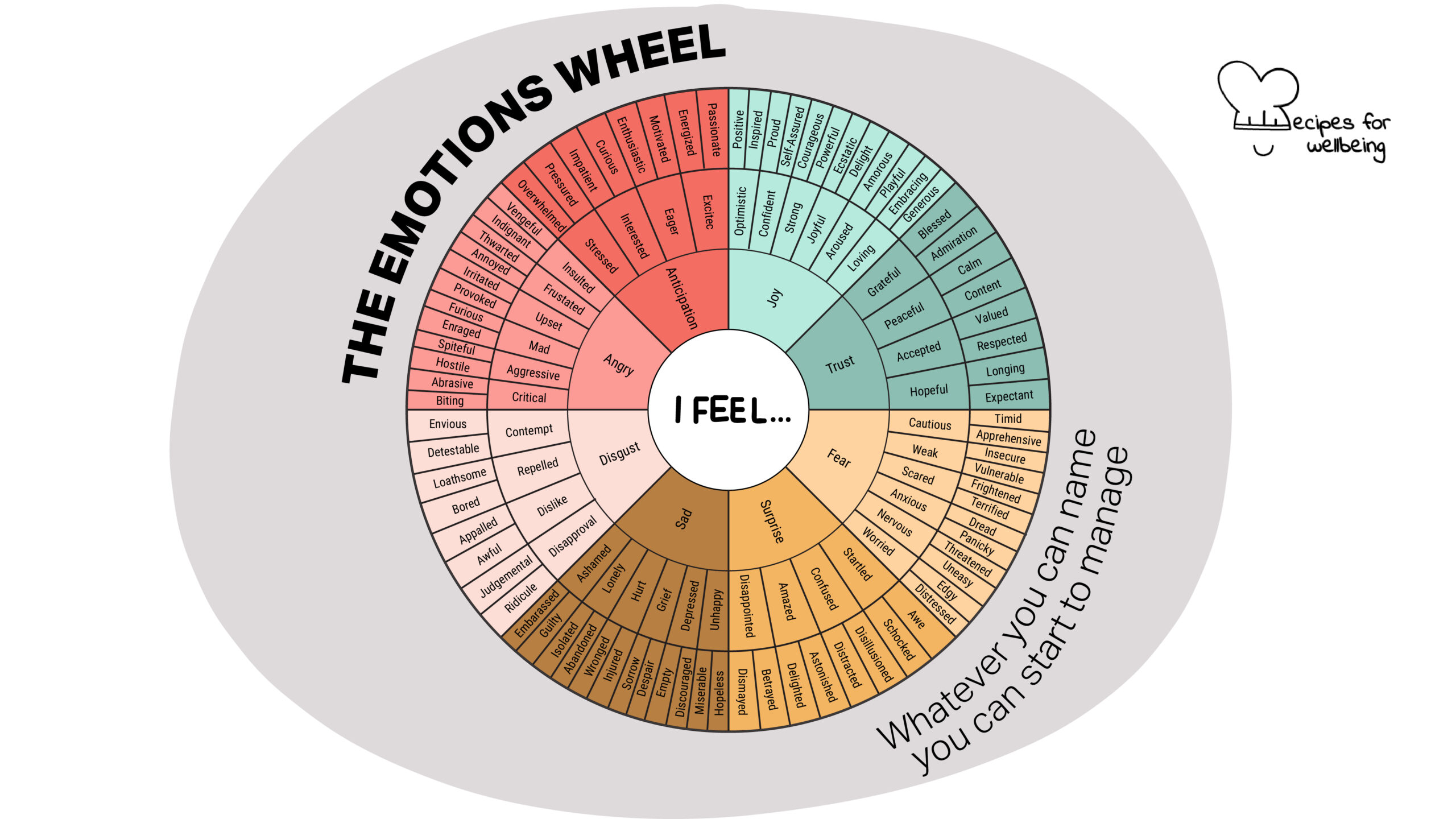
The wheel of emotions and feelings
Between stimulus and response there is a space. In that space is our power to choose our response. In our response lies our growth and our freedom. ―Viktor E. Frankl
👥 Serves: 1 person, 11-25 people, 2-10 people, 26-40 people, 41+ people
🎚 Difficulty: Medium
⏳ Total time: 11-30 minutes
🥣 Ingredients: The wheel of emotions and feelings template (either printed or digital), your team
🤓 Wholebeing Domains: Awareness, Community, Discomfortability, Liberatory Learning, Radical Care
💪 Wholebeing Skills: Centring, Check-in, Clarity, Conflict transformation, Emotional intelligence, Hosting conversations, Mind-body-connection, Reflection, Self-awareness, Self-regulation

The wheel of emotions and feelings
📝 Description
A compass to name your emotions and feelings and build emotional regulation in teams.
We overestimate the power of the rational mind and underestimate the influence of emotions on our choices and behaviours. If channelled in healthy ways, emotions can be a great source of insight, wisdom, and power. So, it is important to build your capacity to regulate your emotions, both individually and in your team.
At its simplest, emotional regulation means changing the trajectory of an emotional response. You can choose to ‘downregulate’ or ‘upregulate’ your emotions (e.g. controlling your anger towards a situation or increasing your excitement for a new activity). Emotional regulation is both an individual and collective skill that is essential for high-performing teams. It goes beyond individuals managing their emotions and it involves creating an environment where everyone contributes to a positive and supportive workspace.
Some of the benefits of emotional regulation include an increase in pleasure and a reduction in pain, as well as a minimisation of feelings of negativity and sadness. Moreover, emotional regulation can help manage interpersonal interactions to avoid or transform conflicts and it can support the optimisation of how information is processed to enhance individual and team performance.
The following activity helps you and your team navigate challenging conversations by developing:
- Somatic awareness: What is your body telling you?
- Emotional granularity: What emotions are you experiencing?
- Emotional regulation: Are you down- or up-regulating your emotions?
The wheel of emotions and feelings depicted above is inspired by Dr Robert Plutchik’s petal model. If you wish to explore another tool for emotional self-regulation in teams, check out our recipe “Emotional regulation in teams”. You may also benefit from introducing the concept of emotional agility in your team through our recipe “Developing emotional agility”.
👣 Steps
Step 1 – Familiarise with the wheel of emotions and feelings (5’)
Either before or at the start of a sensitive conversation, invite the people involved to familiarise themselves with the wheel of emotions and feelings, which consists of 8 primary emotions (joy, trust, fear, surprise, sadness, disgust, anger, and anticipation) and a lot more nuanced and subtle emotions and feelings.
Step 2 – Check-in at the start (5’)
Once people have familiarised themselves with the wheel of emotions and feelings, ask each of them to reflect for a minute on the emotions/feelings they are experiencing as they enter the conversation, before sharing them with the rest of the group. You can ask them to share verbally or in written form (e.g. on a sticky note if in person or via the chat box if online).
- If you are meeting in person, you may consider printing out the wheel of emotions and feelings on a large piece of paper and marking the named emotions with a specific colour.
- If you are meeting online, you may consider having a digital version of the wheel of emotions and feelings where you can mark the named emotions/feelings with a specific colour.
Once people have named their emotions/feelings, invite them to reflect on whether they are down- or up-regulating them and, if there is enough trust in the team, invite them to share this.
Step 3 – Check-in halfway through the conversation (5’)
Repeat the process of asking people to pause for a moment and name their emotions/feelings (and whether they’re down- or up-regulating them) half-way through the conversation. This pause allows for the people involved to slow down and re-centre, especially if it’s a heated conversation, and to expand their awareness beyond themselves to consider how other people are experiencing the conversation. Again, we advise you to mark the emotions on the wheel using a different colour.
Step 4 – Check-in at the end (10’)
As the conversation comes to a close, invite participants to pause once again and name their emotions/feelings. How are they leaving the conversation? Mark their responses in the wheel of emotions and feelings using a different colour. This will give you a full map of how the group moved through the conversation on an emotional level, which might spark helpful insights about the emotional wellbeing of your team and their ability to regulate their emotions/feelings.

